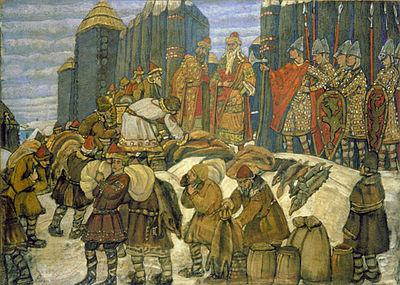Tiun is an established generic name for a number of categories that included personal princely and boyar servants. This name was also called in ancient Russia by civil servants, or rather, their posts in the administrative and judicial field.
Value
In Kievan Rus, tiun (tivun) was called a princely or boyar steward, clerk, steward, in the Grand Duchy of Lithuania and in the Moscow state until the 17th century. - name of economic, viceroyalty, church and judicial posts. The function itself has Scandinavian roots and came to the territory of Russia thanks to the Varangians (dr.-Scand. Thionn). The etymology of the word demonstrates its very wide distribution: from Old Russian this word means “manager”, in Ukrainian it means “overseer”, “manager of the estate”. Tiun is also a servant of the princely court, and also the lower level of administration in the villages.
Tiun in Russia
Tiun in Ancient Russia - these are household managers who are in the service of the boyars or princes and are responsible for the order. Fire, later name - palace, was responsible for the house, yard. Stable tyun, respectively, was responsible for horses and stalls, work in the stable. On the rural and military field work lay, etc. Tiuns were the most necessary support and help for feudal landowners in administration and court. Most of them were not free. As the “Russian Truth” says, as soon as a person accepted a position called “tyun”, he passed into the category of those who are called a slave. In order to preserve his freedom, it was necessary at the same time to conclude a special agreement. The Russian Truth also refers to “Tivun without a row” (this means the absence of a proper contract) as one of the sources of servility. Despite this, the social status of princely tyuns was very high. For the murder of a rural or military man - 12 hryvnia, for the murder of a servant of the boyar - 40 hryvnia. For the princely fiery set the largest size - 80 hryvnia.

The serf-tyun was allowed to be a witness in court, unless there were other free ones, although the rule read “lay obedience to the serf”. At the same time, the trial could only be conducted by the prince personally. Minor officials who belonged to the judiciary were also called tyunas. They were appointed by princes, volostel or governors. In the 13-14 centuries, the number of governor tiuns was determined using the charter. If we compare the court of secondary officials with that of the governor, the first was the lowest authority. Despite the fact that the reward of tyun was carried out on an equal footing, his income half did not reach the profit of the governor. The population rebelled against officials that they hated (we can recall the uprising of the inhabitants of Kiev in 1146). In literary monuments, tyun is a selfish oppressor of the people (for example, in the Word of Daniel the Sharpener).
Tiunas in the Moscow State and the Grand Duchy of Lithuania
Here the emphasis shifts from economic to managerial and judicial functions. In the 14-17 centuries. continued to exist princely tyun, engaged in his economy. They were also included in the governorate apparatus and those on which the judicial functions lay. The Grand Duchy of Lithuania nicknamed the tyunans of large feudal lords who were responsible for managing the volosts (later they began to call them governors) and collected tribute (which at that time was also called "polyudy"). In some parts of Galician Rus, where remnants of Old Russian law still existed, such were elected representatives of rural communities.
Tiunas and the Church
Church tyuns were of two kinds: those who were subordinate to secular bishops' officials, and those who were called "masters." The last group lived in a cathedral city and served with the bishop himself. According to the decree of the Stoglavy Cathedral, the main duty of the tyun was to issue banners to the priests who attended the cathedral and were hired to serve the liturgy. The latter were the right to carry out such actions. Later tyuns are responsible for order in the church. They watch how clergy and priest elders fulfill their duty.
Tiun hut
Tiun, whose significance was great at the church, and the priests' elders sat together in the hut of Popovskaya, and then in Tiunskaya until 1667. However, the situation has changed. From 1674 to 1690, the Tiun hut was replaced by patriarch Joachim on the orders of church affairs. In 1724, it was finally closed. The bishops followed the example of the patriarch and brought into fashion the opening of the Tiun huts or orders. The latter were responsible for the same matters relating to diocesan administration as in the old days and tyun. To create assistance to the Synod during the time of Peter I, a chamber was created, which was also called an office, but already the following year it was abolished.
Tiun is a person who was deprived of his freedom, but was also endowed with a lot of responsibilities. These people watched the house, field, animals, occupied a certain position in the church or were officials.